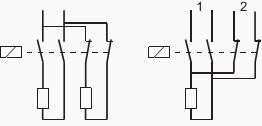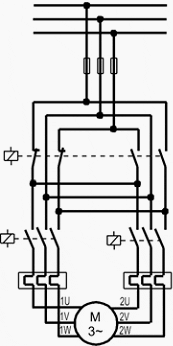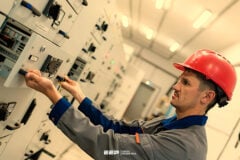
Introduction
The majority of low-voltage switchgear is equipped with three contacts in the main circuit, which switch three-phase loads in all poles. In some applications switchgear with four main poles is required, either for safety reasons or for an optimum solution of the application.
This may require various device configurations.
Applications of switchgear with 4 NO contacts
Four NO contacts are required or at least very advantageous for the below applications:
Application no.1
Applications which require the interruption of the neutral line for switching off or disconnecting loads. This can be the case in supplies with adverse grounding conditions, in TT supplies, for protective disconnection in IT or impedance-grounded networks. Attention has to be paid that the neutral pole closes before or at the same time as the other poles and opens after them or at the same time.
When switching non-linear consumers, specific attention has to be paid regarding the current loading of the neutral line.
The effect of higher frequencies on the performance of low-voltage devices should be considered both in networks with higher basic frequencies (for example 400 Hz) and also in cases where current-harmonics occur. Such current-harmonics occur if the supply voltage contains harmonics or if non-linear consumers are connected.
Such consumers may for example be compensation devices for luminescent lamps that operate in the range of saturation or devices with phase angle control. With consumers with phase angle control and with frequency converters harmonics with frequencies up to several kHz may arise in the supply. The harmonic content can be increased by capacitors connected to the supply, whose current consumption increases with increasing frequency.
In applications in which current-harmonics arise, the effect of the harmonics (for example additional heating effects) is added to that of the basic frequency. This can be especially critical in devices that contain coils or ferromagnetic materials (bimetal heating coils, magnetic releases etc.).
In the case of loads with connection to the neutral conductor (e.g. single-phase loads such as luminescent lamps, small power adapters etc.), a high harmonic content can result because of the formation of a zero-sequence-system that may lead to thermal overloading. This should also be taken into account in the use of 4-pole switchgear.
Application no.2
Switching-over of supply systems (for example for standby power supplies), for which complete separation of the two supply systems is required.
Application no.3
Switching of several single-phase loads (heaters, lamps) with one switchgear unit.
Application no.4
Switching direct current loads with higher rated voltage that requires the series connection of four contacts.
Switchgear designed for alternating current can carry at least the same rated continuous operational DC current. With direct current the skin effect in the circuits disappears and none of the specific effects associated with alternating currents such as hysteresis or eddy current losses occur.
With voltages in excess of around 60 V, the direct current switching capacity of AC switchgear with double-breaking contacts (for example contactors) decreases strongly. By connecting two or three circuits in series (Figure 1) this limit can be raised to twice or three times the voltage.

With direct voltages, the contact erosion and hence also the contact life span differ from those at alternating voltage. The attainable values for direct current are specifically tested and documented. With direct current, the load affects the switching capacity more strongly than with alternating current. The energy stored in the inductance of the load must largely be dissipated in the form of an electric arc.
Hence with a strongly inductive load (large time constant L/R) the permissible switching capacity for the same electrical life span is smaller than with an ohmic load due to the much longer breaking times.
Applications of switchgear with 2 NO and 2 NC contacts
Devices with two NO and two NC contacts are useful in applications in which one of two circuits must always be closed.
These are, for example:
- Switching a heater between two levels (Figure 2)
- Switching-over between single-phase supplies – for example, emergency power supply systems (Figure 2)
- Reversing motors for space saving arrangement of devices (Figure 3)
- Reversing of 2-step motors with separated windings (Figure 4)



Applications of switchgear with 3 NO and 1 NC contact
Devices with three NO and one NC contact are used in applications in which, when the main load is switched off – for example the motor –, another single-phase load must be switched on.
Such applications could include:
- Safety circuits
- Direct current brake systems that are activated when a drive is switched off
- Clutches that must be released when the drive is switched off
Resource: Allen Bradley – Low-Voltage Switchgear and Controlgear











Can some one help me regarding 400hz switchboard.
Hello all, Can 4-P breaker become a standard in the near future, even for application where today we have 3-P breaker as a acceptable solution ? In other words, will one day 4-P breaker replace 3-P as they already cover their functionnality ?